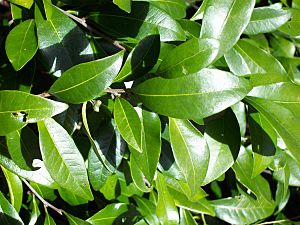Yellow plumwood facts for kids
Quick facts for kids Yellow plumwood |
|
|---|---|
 |
|
| Scientific classification | |
| Genus: |
Pouteria
|
| Species: |
myrsinoides
|
| Synonyms | |
|
|
The Yellow Plumwood, scientifically known as Pouteria myrsinoides, is a cool tree that grows in Australia. It's part of the Sapotaceae family, which includes many trees that produce a milky sap. People also call this tree "axe-handle wood" or "blunt-leaved coondoo."
Contents
Discovering the Yellow Plumwood Tree
This tree is found in different parts of Australia. It likes to grow in rainforests near the coast and also in drier rainforest areas. You can find it from Forster, New South Wales all the way up to Lakeland Downs in tropical Queensland.
A special type of Yellow Plumwood, called reticulata, also grows on Lord Howe Island and in New Caledonia.
What Does Yellow Plumwood Look Like?
The Yellow Plumwood is usually a small tree. It can grow up to 12 metres (about 39 feet) tall. Its main stem can be about 25 centimetres (nearly 10 inches) wide.
The leaves of this tree are quite small. They are usually between 2 to 10 centimetres (about 1 to 4 inches) long. They are also 1 to 4 centimetres (about 0.4 to 1.6 inches) wide.
Flowers and Fruit
The Yellow Plumwood tree usually blooms with flowers between May and November. Sometimes, it can even start flowering as early as February.
After the flowers, the tree produces fruit. The fruit is a thin, purple-black berry. It is about 1.5 to 3 centimetres (about 0.6 to 1.2 inches) long. Each berry usually holds one to three seeds inside.
How It Got Its Name
The scientific name myrsinoides is interesting! It means that the leaves of this tree look similar to the leaves of some plants in the Myrsine genus. Scientists often name plants based on their features or similarities to other plants.

